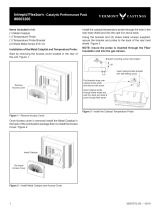
6
Encore
®
Woodburning Stove
2000956
A chimney connector is the double-wall or single-wall
pipe that connects the stove to the chimney. The chim-
ney itself is the masonry or prefabricated structure that
encloses the flue. Chimney connectors are used only to
connect the stove to the chimney, as in Figure 5.
Double-wall connectors must be tested and listed for
use with solid-fuel burning appliances. Single-wall con-
nectors should be made of 24 gauge or heavier steel.
Do not use galvanized connector; it cannot withstand
the high temperatures that can be reached by smoke
and exhaust gases, and may release toxic fumes under
high heat. The connector may be 6” (152 mm) or 8 “
(203 mm) in diameter.
If possible, do not pass the chimney connector through
a combustible wall or ceiling. If passage through a com-
bustible wall is unavoidable, refer to the section on Wall
Pass-Throughs. Do not pass the connector through an
attic, a closet or similar concealed space. The whole
connector should be exposed and accessible for in-
spection and cleaning.
In horizontal runs of chimney connector, maintain a dis-
tance of 24” (610 mm) from the ceiling. Keep it as short
and direct as possible, with no more than two 90° turns.
Slope horizontal runs of connector upward 1/4” per foot
(6 mm per meter) going from the stove toward the chim-
ney. The recommended maximum length of a horizontal
run is 3’ (1 m), and the total length should be no longer
than 8’ (2.4 m). In cathedral ceiling installations, extend
the prefabricated chimney downward to within 8’ (2.4 m)
of the stove.
Information on assembling and installing double-wall
connectors is provided by the manufacturer of the
double-wall pipe. Follow the manufacturer’s instructions
exactly as you assemble the connector and attach it to
the stove and chimney. Using chimneys and connectors
from the same manufacturer makes the assembly and
installation straightforward.
For installations using double-wall connectors,
minimum clearances must conform to the listed clear-
ances in the clearance chart on Page 14.
If the Encore is equipped with the 8” flue collar, an oval-
to-round adapter will be needed. Double-wall oval-to-
round adapters are available from some manufacturers.
Your local dealer can help you select the right connec-
tor.
• Begin assembly at the flue collar of the stove. Insert
the first crimped end into the stove’s flue collar, and
keep each crimped end pointing toward the stove.
(Fig. 5)Using the holes in the flue collar as guides,
drill 1/8” (3mm) holes in the bottom of the first sec-
tion of chimney connector and secure it to the flue
collar with three #10 x 1/2” sheet metal screws.
• Secure each joint between sections of chimney
connector, including
telescoping joints, with at
least three (3) sheet metal
screws. The pre-drilled
holes in the top of each
section of chimney con-
nector serve as guides
when you drill 1/8” (3mm)
holes in the bottom of the
next section.
• Secure the chimney con-
nector to the chimney.
Instructions for various
installations follow.
• Be sure the installed stove
and chimney connector are correct distances from
nearby combustible materials.
Special slip pipes and thimble sleeves that form
telescoping joints between sections of chimney con-
nector are available to simplify installations. They often
eliminate the need to cut individual connector sections.
Consult your local dealer about these special pieces.
Follow the installation instructions of the chimney
manufacturer exactly as you install the chimney. The
manufacturer of the chimney will supply the acces-
sories to support the chimney, either from the roof of
the house, at the ceiling of the room where the stove is
installed, or from an exterior wall.
Special adapters are available from your local dealer
to make the connection between the prefabricated
chimney and the chimney connector. The top of such
adapters attaches directly to the chimney or to the
chimney’s ceiling support package, while the bottom of
the adapter is screwed to the chimney connector.
These adapters are designed so the top end will fit
outside the inner wall of the chimney, and the bottom
end will fit inside the first section of chimney connector.
When assembled in this way, any soot or creosote fall-
ing from the inner walls of the chimney will stay inside
the chimney connector.
ST242
Chimney connector
12/13/99 djt
the crimped end
of the connector points
toward stove.






















